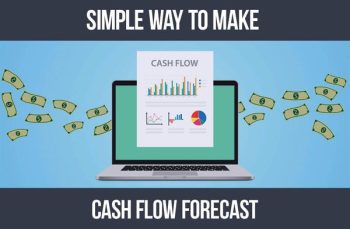Related Blogs
- Analyze the competition before investing in a startup
- How to assess the financial health of a startup
- Loan principal and interest
- 9 Easy Steps to Forecasting Cash Flow
- How to build a successful financial model

The term cash flow forecasting is self explanatory. It does exactly what it says. In a nutshell, it forecasts cash inflows and outflows of a business. A cash flow forecast is important because it demonstrates the ability of the business to remain liquid over a period of time.
Type of cash flow forecast
There are three types of cash flow forecasts:
- Short term forecast
- Medium-term forecasts
- Longer term forecasts
Short-term cash flow forecasts Look a few weeks into the future. They are prepared by the CFO to estimate the daily cash requirements of the business.
Download the Excel template! Learn even more ⟶
Medium-term forecasts are designed to estimate the liquidity of the company. They are used for a period of four months.
Download the Excel template! Learn even more ⟶
Longer term forecasts are a cash flow for 12 months. They are used as a basis for preparing long-term strategies.
Deciding what type of cash flow forecast you need depends on your aim. What do you want to achieve and improve with cash flow analysis? So if you can answer this question, you’ll know exactly what type of forecast you need.
Download the Excel template! Learn even more ⟶
Basic Elements of a Typical Cash Flow Forecast
There is a list of variables that require calculation in order to have quality cash flow forecasts. In other words, these elements are mandatory for a realistic prediction:
- Sales forecasts
- Purchase forecast
- Pay forecast
- Operating Expense Forecast
- Tax forecasts
Sales forecasts predicts the cash inflow of sales. Accordingly, anything that considers the company’s sales should be recognized.
Purchase forecast predicts cash outflow. For this reason, it is essential to consider every output that relates to the preparation of the production process and the sales process.
Pay forecast consists of data for employee salaries.
Operating expense forecast is linked to all operating outputs. They are related to rent, electricity, maintenance and other related outputs.
Tax forecasts Includes all related taxes for the period such as VAT and payroll related taxes.
Creating a Cash Flow Forecast in Five Steps
Bearing in mind the basic elements that every cash flow forecast should have, you should follow these Five steps In order to create it:
- Project your cash inflows – What are your income expectations? Here you need to consider payment and collection terms. For example, if your standard payment terms are 20 days, but your customer pays in 30 days, you need to consider that. In this case, your June sales may be your September earnings.
- Calculate the cash inflow you will collect from your accounts payable –Anport payment terms in mind, include all of your accounts payable entries.
- Incorporate other cash inflows into your forecasts – Not only money collected from your accounts receivable, but also deposits from other projects needs including.
- Specify expenses and cash outflows – Start with fixed and standard expenses such as rent, insurance, electricity, utilities and travel. You can use previous periods for comparison. Also, if you are a startup, doing market research can help.
- Don’t forget your accounts payable and taxes –Have a good overview of your due dates of your accounts payable. Use them as a basis to realistically project your costs over the months. Finally, never forget your tax expenses. Start by including payroll-related taxes, then move on to more complex taxes.
We can help!
In conclusion, these were useful basic concepts that everyone should use when preparing their cash flow forecasts. Creating a quality cash flow forecast is a simple yet demanding task to do. However, defining your goal and gathering quality and realistic data is difficult. Of course, there is a solution for everything. With our team of experts, we can simplify everything. Do not hesitate to Contact us here, anytime. We can help.
